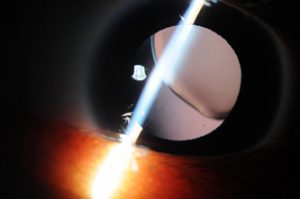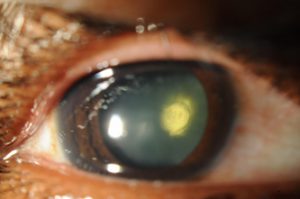Top Ten CICAFE
Dr. Arnaldo Espaillat Matos
CICAFE: Cirugía de catarata con femtosegundo
arnaldo@espaillatcabral.com
1. CICAFE utiliza imágenes de alta resolución del segmento anteriorlogradas por OCT que son integradas con un láser de femtosegundo.Dicho láser actúa guiado por computadora para crear incisionescorneales, realizar la capsulotomía y segmentar el núcleo de la catarata1.
Hasta la fecha la literatura científica publicada evidencia que:
2. Tanto la agudeza visual no corregida (con refracción) como lacorregida para la distancia no muestran diferencias estadísticas oclínicas significativas, o si existe, es muy pequeña (a favor del usodel femtosegundo) entre las técnicas de CICAFE y facoemulsificaciónestándar (FS) 2,3.
3. En cuanto al resultado refractivo, el equivalente esférico absolutoresidual post-CICAFE puede ser menor con respecto a la FS, sin embargo,no siempre es clínicamente significativo 4,5.
4. La capsulotomía láser consigue un mejor centramiento del lenteintraocular, logrando una menor inclinación del mismo y menosaberración óptica de alto orden interna tipo coma vertical, comparadocon la capsulorrexis manual 5-7.
5. Se ha publicado sobre un índice menor de capsulotomías láser Nd:Yagasociadas con CICAFE comparado con cirugías de FS. Otro estudio tratasobre una menor severidad en los índices de opacidad de la cápsulaposterior en CICAFE que en la FS. Esto lo explican por una mayorprecisión de la capsulotomía láser en cuanto a su tamaño, forma ycentrado, lo cual permite una mejor cobertura y sellado de la óptica dellente intraocular, logrando menor migración de células epiteliales 8,9.
6. Se logra mayor reproducibilidad y exactitud en la construcción de lospasos de la cirugía de la catarata. Además, se pueden personalizar lospasos quirúrgicos atendiendo a las particularidades de cada caso 10.
7. Se reduce el tiempo efectivo de ultrasonido empleado, la energía disipadaacumulada en cámara anterior y la pérdida endotelial con respecto a la FS11,12,13,14.
8. CICAFE se asocia a una reducción estadísticamente significativa encuanto al riesgo de pérdida de vítreo y, por lo tanto, mejora la seguridaddel procedimiento quirúrgico 16.
9. La literatura científica informa haber una incidencia de desgarro capsularde un 2 % en la FS. Durante la curva de aprendizaje en los láseres defemtosegundo de primera generación la incidencia reportada era de un4 %. Con los recientes avances en software y hardware de dichos láseres,la incidencia se ha reducido a un 0,2 % 10-18.
10. Ha demostrado ser muy útil en situaciones especiales de cirugíade catarata como lo son: en casos con bajo conteo endotelial,pseudoexfoliación capsular, cataratas subluxadas (figura 1), cataratastraumáticas, cataratas duras 11, cataratas polares posteriores 16 (figura2), en cámaras anteriores estrechas, en cataratas asociadas con lentesintraoculares fáquicos, etc.
Bibliografía
1- Centurión V, Espaillat Matos A, Orlich Dundorf C. Los Conceptos Básicos. En: CICAFE. Cirugía de la Catarata con Láser de Femtosegundo. Centurión V, Espaillat Matos A, Orlich Dundorf C. Panama: Jaypee-Highlights Medical Publishers, Inc., 2016, p. 4.
2- Mastropasqua L, Toto L, Mastropasqua A, et al. Femtosecond laser versus manual clear corneal incision in cataract surgery. J Refract Surg. 2014;30(1):27-33.
3- Lawless M, Bali SJ, Hodge C, Roberts TV, Chan C, Sutton G. Outcomes of femtosecond laser cataract surgery with a diffractive multifocal intraocular lens. J Refract Surg. 2012;28(12):859-864.
4- Chee SP, Yang Y, Ti SE. Clinical outcomes in the first two years of femtosecond laser-assisted cataract surgery. Am J Ophthalmol. 2015;159(4):714-719.
5- Kranitz K, Mihaltz K, Sandor GL, et al. Intraocular lens tilt and decentration measured by Scheimpflug camera following manual or femtosecond laser-created continuous circular capsulotomy. J Refract Surg 2012; 28:259-263.
6- Espaillat A, Pérez O, Potvin R. Clinical outcomes using standard phacoemulsification and femtosecond laser-assisted surgery with toric intraocular lenses. Clinical Ophthalmology 2016; 10:555-563.
7- Miháltz K, Knorz MC, Alió JL, Takács AI, Kránitz K, Kovács I, Nagy ZZ. Internal aberrations and optical quality after femtosecond laser anterior capsulotomy in cataract surgery. J Refract Surg 2011; 27(10):711-6.
8- Tran DB, Vargas V, Potvin R. Neodymium:Yag capsulotomy rates associated with femtosecond laser-assisted versus manual cataract surgery. J Cataract Refract Surg 2016; 42:1470-1476.
9- Kovács I, Kránitz K, Sándor Gl, et al. The effect of femtosecond laser capsulotomy on the development of posterior capsule opacification. J Refract Surg 2014; 30:154-158.
10- Roberts TV, Lawless M, Sutton G, Hodge C. Update and clinical utility of the LenSx femtosecond laser in cataract surgery. Clinical Ophthalmology 2016; 10:2021-2029.
11- Hatch KM, Schultz T, Talamo JH, Dick B. Femtosecond laser-assisted compared with standard cataract surgery for removal of advanced cataracts. J Cataract Refract Surg 2015; 41:1833-1838.
12- Prasad Reddy K, Kandulla J, Auffarth GU. Effectiveness and safety of femtosecond laser-assisted lens fragmentation and anterior capsulotomy versus the manual technique in cataract surgery. J Cataract Refract Surg. 2013;39:1297-1306.
13- Daya SM, Nanavaty MA, Espinosa-Lagana MM. Translenticular hydrodisecction, lens fragmentation, and influence on ultrasound power in femtosecond laser-assisted cataract surgery and refractive lens exchange. J Cataract Refract Surg. 2014; 40:37-43.
14- Conrad-Hengerer I, Al Juburi M, Schultz T, Hengerer FH, Dick HB. Corneal endothelial cell loss and corneal thickness in conventional compared with femtosecond laser-assisted cataract surgery: three-month follow-up. Cataract Refract Surg 2013; 39:1307-13.
15- Packer M, Solomon JD. Impact of crystalline lens opacification on effective phacoemulsification time in femtosecond laser-assisted cataract surgery. Am J Ophthalmol 2014; 157:426-432.
16- Scott WJ, Tauber S, Gessler JA, et al. Comparison of vitreous loss rates between manual phacoemulsification and femtosecond laser-assisted cataract surgery. J Cataract Refract Surg 2016; 42:1003-1008.
17- Vasavada AR, Vasavada V, Vasavada S, et al. Femtodelineation to enhance safety in posterior polar cataracts. J Cataract Refract Surg 2015; 41:702-707.
18- Popovic M, Campos-Moller X, Schlenker MB, Ahmed IK. Efficacy and safety of femtosecond laser-assisted cataract surgery compared with manual cataract surgery. A meta-analysis of 14567 eyes. Ophthalmol 2016; 123:2113-2126.


Figura 1. Cristalino subluxado en el síndrome de Marfan.

Figura 2. Catarata polar posterior.
